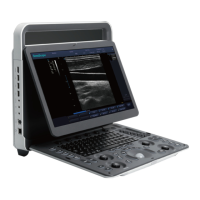1 Safety
Basic User Manual 7
Mechanical bioeffects are threshold phenomena that occur when a certain level of output is
exceeded. The threshold level varies, however, with different types of tissue. The potential
mechanical bioeffects varies with peak pressure and ultrasound frequency. The MI accounts
for these two factors. The higher the MI value, the greater the likelihood of mechanical
bioeffects occurring. There is no specific MI value that means that a mechanical effect
is actually occurring. The MI should be used as a guide for implementing the ALARA
principle.
●
Thermal Index (TI)
The TI value informs the operator about the conditions that might lead to an increase
in temperature on the surface of the body, within the body tissue, or at the point of
focus of the ultrasound beam on bone. That is, the TI value informs the operator about
the potential temperature rise in body tissue. It is an estimate of temperature increase
in body tissue with specific properties. The actual amount of any temperature rise is
influenced by factors such as tissue type, vascularity, mode of operation and others.
The TI value should be used as a guide for implementing the ALARA principle.
Depending on the examination and type of tissue involved, TI could be one of three
types:
−
Soft Tissue Thermal Index (TIS) is used when imaging soft tissue only, it provides
an estimate of potential temperature rise in soft tissue.
−
Bone Thermal Index (TIB) is used when bone is near the focus of the image as in
the trimester, it provides an estimate of potential temperature rise in the bone or
adjacent soft tissue.
−
Cranial Bone Thermal Index (TIC) is used when bone is near the skin surface as in
transcranial examination, it provides an estimate of potential temperature rise in the
bone or adjacent soft tissue.
■ MI/TI Display
TI and MI values are displayed in the real time scan on the screen. The operator should
observe these index values during examinations and ensure that exposure time and output
values are maintained at the minimum amounts needed for effective diagnosis.
The MI and TI precision is 0.1.
1.3.4 Probe Surface Temperature Limits
For probes intended for internal applications, e.g. the endocavitary probe or
transesophageal probes, the surface temperature of the probe may change by adjusting
system parameters.

